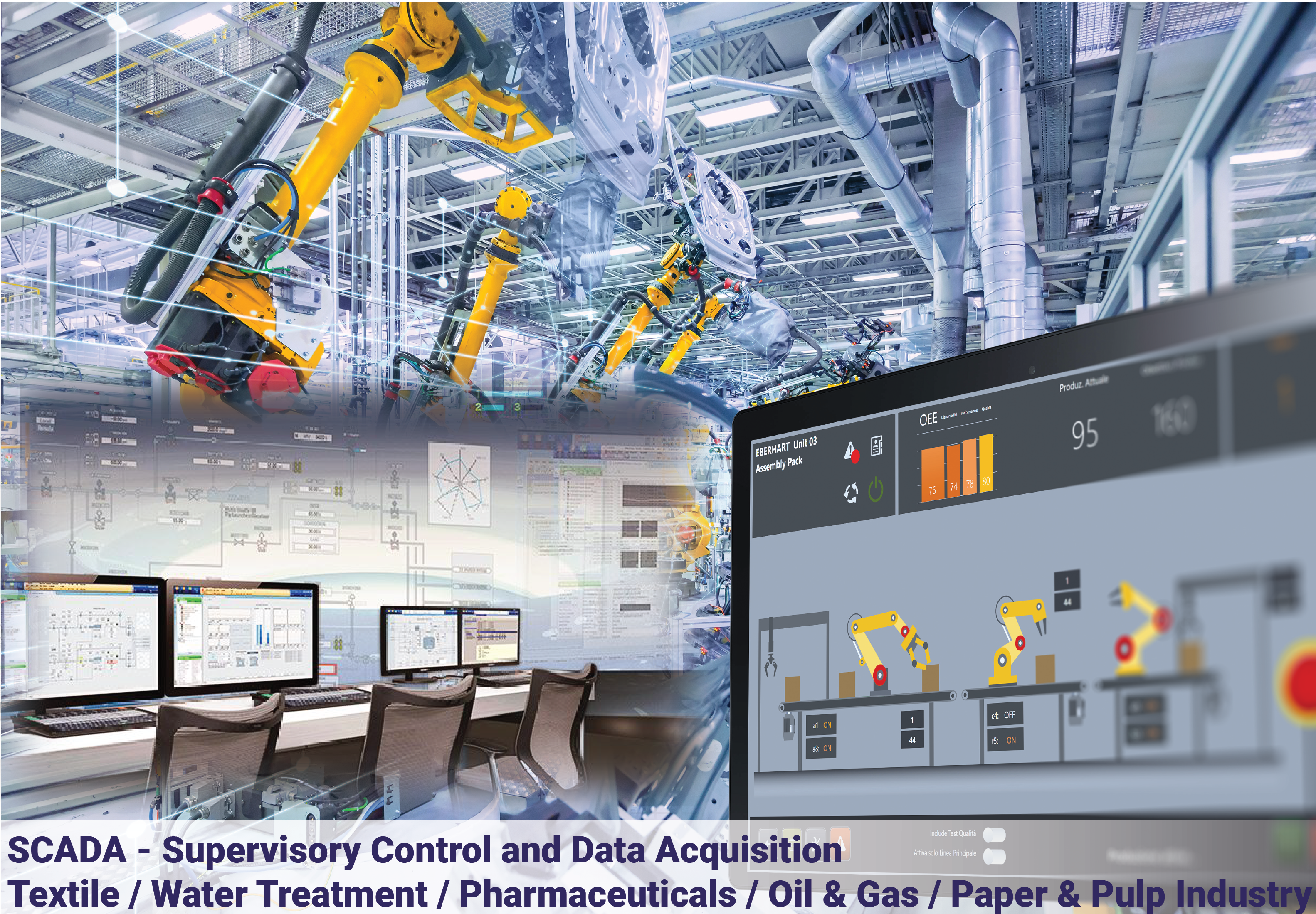
Supervisory Control and Data Acquisition (SCADA) systems are used for controlling and monitoring industrial processes, infrastructure, and facilities. Here’s a comprehensive overview:
### Components of a SCADA System
1. **Human-Machine Interface (HMI):**
– The interface that operators use to interact with the SCADA system.
– Displays data, process schematics, and allows control commands.
2. **Supervisory System:**
– Centralized servers that gather data from field devices.
– Processes and stores data, executes control commands.
3. **Remote Terminal Units (RTUs):**
– Field devices that connect to sensors and actuators.
– Collect data and communicate with the central SCADA system.
4. **Programmable Logic Controllers (PLCs):**
– Often used as field devices like RTUs.
– Execute control logic locally and interface with the SCADA system.
5. **Communication Infrastructure:**
– Networks (wired, wireless, or a combination) that facilitate data transfer between SCADA components.
– Includes protocols like Modbus, DNP3, and IEC 60870-5-104.
### How SCADA Systems Work
1. **Data Acquisition:**
– Sensors collect data from the physical process (e.g., temperature, pressure, flow rate).
– RTUs and PLCs convert this data into digital signals and send it to the supervisory system.
2. **Data Communication:**
– Data is transmitted over communication networks to the central servers.
– Real-time data is continuously updated.
3. **Data Processing:**
– Central servers process incoming data for monitoring and control.
– Data can be logged for historical analysis.
4. **Control:**
– Operators use the HMI to monitor processes and issue control commands.
– Commands are sent back to the RTUs/PLCs to adjust actuators (e.g., opening a valve, adjusting a motor speed).
5. **Data Presentation:**
– HMI displays real-time data, trends, alarms, and process schematics.
– Provides visualization tools for better understanding and decision-making.
### Applications of SCADA Systems
– **Industrial Automation:**
– Manufacturing, assembly lines, robotic control.
– **Utility Management:**
– Water and wastewater treatment plants, electrical grids, gas pipelines.
– **Transportation:**
– Railway systems, traffic signals, airport operations.
– **Building Management:**
– HVAC systems, security, energy management.
– **Oil and Gas:**
– Refining, distribution, pipeline monitoring.
### Benefits of SCADA Systems
– **Enhanced Monitoring:**
– Real-time data acquisition and visualization.
– **Improved Control:**
– Central
ized control over complex processes.
– **Increased Efficiency:**
– Optimizes operations, reduces downtime, and enhances productivity.
– **Data Logging and Analysis:**
– Historical data for performance analysis and troubleshooting.
– **Scalability:**
– Can be expanded to include additional devices and processes.
– **Remote Access:**
– Enables control and monitoring from remote locations.
### Example Use Case
Consider a water treatment plant using a SCADA system:
1. **Data Acquisition:**
– Sensors measure water levels, flow rates, and chemical concentrations.
– RTUs gather this data and send it to the SCADA central system.
2. **Data Communication:**
– Data travels over a secure network to the central servers.
3. **Data Processing:**
– Central servers process incoming data, triggering alarms if levels are abnormal.
4. **Control:**
– Operators adjust pumps, valves, and chemical dosages using the HMI.
5. **Data Presentation:**
– HMI displays real-time status of the plant, historical trends, and alarm notifications.
### Challenges and Considerations
– **Cybersecurity:**
– SCADA systems are often critical infrastructure, making them targets for cyber-attacks.
– Security measures such as encryption, firewalls, and intrusion detection are essential.
– **Integration:**
– Integrating SCADA systems with existing IT infrastructure and different communication protocols can be complex.
– **Maintenance:**
– Regular updates and maintenance are necessary to ensure system reliability and performance.
– **Cost:**
– Initial setup and implementation can be expensive, though the long-term benefits often justify the investment.
In summary, SCADA systems play a crucial role in industrial automation and infrastructure management by providing real-time monitoring, control, and data analysis capabilities. They enhance operational efficiency, improve decision-making, and ensure the reliability of critical processes and services.
Several SCADA (Supervisory Control and Data Acquisition) software solutions are widely used across various industries for their robustness, scalability, and extensive feature sets. Here are some of the most popular SCADA software platforms:
### 1. **Wonderware InTouch (by AVEVA)**
– **Features:** Highly intuitive HMI design, real-time data visualization, powerful scripting capabilities, extensive library of pre-built graphics, and comprehensive alarm management.
– **Industry Applications:** Manufacturing, water/wastewater, energy, food and beverage.
### 2. **Ignition (by Inductive Automation)**
– **Features:** Web-based deployment, unlimited tags and clients, SQL database integration, cross-platform compatibility, modular architecture, and extensive scripting and automation tools.
– **Industry Applications:** Manufacturing, utilities, transportation, oil and gas.
### 3. **Siemens WinCC**
– **Features:** Seamless integration with Siemens automation products, scalable architecture from single-user systems to complex multi-user systems, robust data logging and analysis tools, and advanced alarm management.
– **Industry Applications:** Automotive, chemical, pharmaceutical, water and wastewater.
### 4. **GE iFIX (by GE Digital)**
– **Features:** Advanced data visualization, robust data acquisition, high availability and redundancy, extensive historical data analysis, and tight integration with GE’s Predix platform for Industrial Internet of Things (IIoT) applications.
– **Industry Applications:** Utilities, manufacturing, food and beverage, water and wastewater.
### 5. **Schneider Electric EcoStruxure™ Operator Terminal Expert (formerly known as Vijeo Designer)**
– **Features:** Intuitive touch interface design, extensive device integration capabilities, comprehensive alarm and event management, secure remote access, and integration with Schneider Electric’s EcoStruxure™ platform.
– **Industry Applications:** Energy management, water/wastewater, building automation.
### 6. **Citect SCADA (by AVEVA)**
– **Features:** Highly configurable, robust process control capabilities, rich graphical user interfaces, advanced alarm and event management, and comprehensive reporting and data analysis tools.
– **Industry Applications:** Mining, manufacturing, water and wastewater, oil and gas.
### 7. **FactoryTalk View (by Rockwell Automation)**
– **Features:** Scalable solutions for single-user applications to multi-site enterprises, integrated with Rockwell Automation’s controllers and devices, real-time data and trending, and robust security features.
– **Industry Applications:** Automotive, food and beverage, pharmaceuticals, water and wastewater.
### 8. **Movicon.NExT (by Progea)**
– **Features:** Highly flexible and scalable architecture, powerful 3D graphics, extensive IIoT and Industry 4.0 features, and strong interoperability with various industrial protocols.
– **Industry Applications:** Manufacturing, energy, water and wastewater, infrastructure.
### 9. **AVEVA System Platform (formerly Wonderware System Platform)**
– **Features:** Enterprise-wide SCADA capabilities, model-driven approach for reusable engineering, centralized management, extensive data visualization and reporting, and high availability and disaster recovery options.
– **Industry Applications:** Oil and gas, energy, food and beverage, water and wastewater.
### 10. **ICONICS GENESIS64**
– **Features:** 64-bit SCADA solutions, integrated with Microsoft technologies, extensive visualization and analysis tools, real-time and historical data management, and robust mobile and web-based access.
– **Industry Applications:** Building automation, manufacturing, utilities, transportation.
### Key Considerations When Choosing SCADA Software
1. **Scalability:**
– Ensure the software can grow with your needs, from small installations to large-scale enterprise deployments.
2. **Integration:**
– Look for compatibility with existing hardware and other software systems in use.
3. **User Interface:**
– An intuitive and customizable HMI is essential for effective monitoring and control.
4. **Security:**
– Robust security features to protect against cyber threats.
5. **Support and Training:**
– Availability of comprehensive support, documentation, and training resources.
6. **Cost:**
– Consider both initial setup costs and ongoing maintenance and licensing fees.
Choosing the right SCADA software depends on the specific requirements of your application, including the scale of the system, the industry standards, and the existing infrastructure.
SCADA Training Ahmedabad
- SCADA Courses Ahmedabad
- SCADA Certification Ahmedabad
- Best SCADA Training Institute Ahmedabad
- SCADA Programming Training Ahmedabad
- Advanced SCADA Training Ahmedabad
- PLC SCADA Training Ahmedabad
- Industrial SCADA Training Ahmedabad
- SCADA System Training Ahmedabad
- SCADA Training Center Ahmedabad
- SCADA Workshop Ahmedabad
- Affordable SCADA Training Ahmedabad
- Professional SCADA Training Ahmedabad
- SCADA Training for Beginners Ahmedabad
- SCADA Training with Job Placement Ahmedabad
- Hands-on SCADA Training Ahmedabad
- SCADA Training Courses Near Me Ahmedabad
- Certified SCADA Training Ahmedabad
- SCADA Training Classes Ahmedabad
- SCADA Automation Training Ahmedabad
Training Program | SCADA Control Systems |
Mode of Learning | On Line / Off Line / Work Shop / Company Floor / Plant Floor |
Offline Locations | Ahmedabad / Surat / Baroda / Rajkot |
Online Locations | PAN India, All Cities in India, America/ Europe/ Middle East – International Timings are available |
Eligibility / Engineering Branches
| Students from 10th 12th ITI, B.E B. Tech Degree /Diploma / Masters /Graduates Electrical / Electronics / Instrumentation / Mechatronics / Power Electronics , B.Sc., M.sc from Electronics , Physics , Working Professionals |
Duration | 1 Month / 30 Days / Customized |
Contents | Standard & Advance |
Supplements | Demo Software, Examples, Theory, Practical Reading Materials Included |
Placements | Jr. Engineer / Project / Site / Field/ Programmer / |
Companies | OEM / System Integrators / Manufacturing Companies / MNC |
Salaries | 25,000 – 35,000 for Fresher / Experienced |
.
